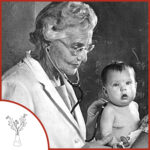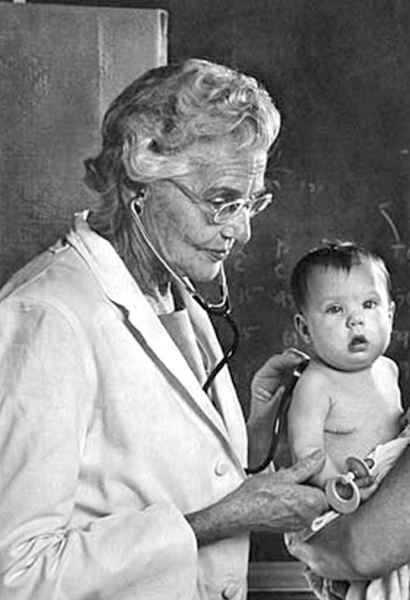

Birth: May 24, 1898
Death: May 20, 1986
Specialty: Pediatric Cardiology
Major Contributions:
Blalock-Taussig-Thomas shunt
Founder, pediatric cardiology
Helped ban thalidomide in the U.S.
Image Courtesy of the National Library of Medicine
Growing up in the early 1900’s, Dr. Helen Taussig had trouble in school. She had dyslexia and struggled to read her entire life – but that didn’t stop her from a pioneering medical career.
Taussig studied at both Harvard and Boston University but due to sexist policies she was not allowed to earn a degree, even after she published her first paper on the heart. Applying to Johns Hopkins University School of Medicine, she was accepted as a full student earning her medical degree in 1927. Completing a year fellowship in cardiology at the school, she followed it up with a two-year internship in pediatrics. In 1930 she was hired by the school as the head of the children’s heart clinic at Johns Hopkins where she spent her entire career.
At this point of her life Taussig has lost most of her hearing, relying on lip reading and hearing aids to communicate, and using her hands to feel the heartbeats of her patients. It is thought that by using touch she was more able to distinguish between normal and abnormal heartbeats.
Specializing in anoxemia or “blue baby” syndrome, a congenital heart condition, she discovered that these babies had a leaking septum and an underdeveloped artery leading to the heart and lungs. Along with two colleagues she developed a surgical procedure, now known as the Blalock-Taussig operation, that successfully treated the condition. Continuing her research on the heart and birth defects, she published Congenital Malformations of the Heart in 1947.
Traveling to West Germany in 1962 she investigated an outbreak of congenital deformities in Europe, coming to the same conclusion as German physicians that the drug thalidomide was the cause. Taussig shared her findings in journal articles and in front of the U.S. Congress leading to the U.S. Food and Drug Administration banning the sale of the drug.
A year later she retired from Johns Hopkins, but never left her work – publishing close to forty articles after retirement and at 67 she became the first woman to hold the office of President of the American Heart Association.
For her work in pediatric cardiology, including founding the subspeciality, she was awarded the Medal of Freedom in 1964.
Written by Angela Goad
Sources:
Changing the Face of Medicine: Dr. Helen Brooke Taussig
Jewish Women’s Archive: Helen Brooke Taussig
WETA: Footprints Through Time: Helen Taussig (1898-1986) (Archived)
See Also:
